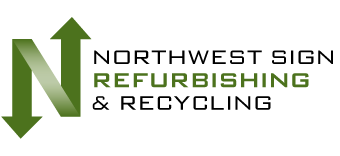Celebrating the Sign Recycling Success of Oregon’s Sign Reuse Program
In June 2012, Governor Kitzhaber visited Northwest Sign Recycling (NWSR) and praised the innovative Oregon Sign Reuse pilot program. This initiative, launched in February 2012, demonstrated significant success in reducing costs while promoting sustainability. Government agencies should take note of this effective approach to managing public resources.
A Positive Impact on the Budget
The state’s sign budget experienced an impressive 41% savings during the initial phase of the program. NWSR transformed 500 outdated aluminum street signs through a process called hydrostripping. This technology left the signs in virtually new condition, offering a sustainable solution for municipalities seeking to cut costs.
Governor Kitzhaber highlighted the program’s benefits, stating that it supported local economic development. The success of NWSR underscored the transformative power of collaboration between government and businesses. Such partnerships create positive ripple effects throughout communities and enhance regional economies.
Efficient Sign Recycling Practices
NWSR operated the pilot program under a $150,000 contract from the Oregon State Department of Transportation (ODOT). This collaboration allowed the company to recycle outdated signs effectively. NWSR utilized hydrostripping technology, which involved removing reflective sheets from the aluminum signs with only water.
This innovative method operated at a pressure of 36,000 pounds per square inch. As a result, the aluminum surface remained smooth and clean, ready for new reflective sheeting. Importantly, this process avoided harmful chemicals and erosive solutions, making it one of the most environmentally friendly options available.
Job Creation and Regional Development
Beyond saving money, the program generated new jobs in Central Oregon. NWSR’s efforts not only provided cost-effective solutions for sign recycling but also stimulated economic growth. Local residents benefited from employment opportunities and increased business activity.
ODOT’s Sign Shop in Salem received over 500 resurfaced sign blanks during the pilot program. Lori Webb, from the ODOT Sign Shop, expressed enthusiasm about the project’s early success. She described it as a “true win-win for the environment and Oregon’s sign budget.” Such testimonials highlight the importance of sustainability-focused programs.
A Model for Other States
NWSR’s achievement in Oregon has set a compelling example for other states and municipalities to follow. The pilot project demonstrated that government agencies could achieve substantial cost savings while supporting green initiatives. The results of this program are a powerful testament to the benefits of recycling and sustainable practices.
The collaboration between NWSR and ODOT established a new standard in public resource management. By implementing similar initiatives, other government agencies can also enhance their budgets and help protect natural resources.
Key Benefits of Sign Recycling
Government agencies should consider the numerous advantages of sign recycling. First and foremost, recycling saves municipalities and agencies money. By reusing existing signs, they can reduce the need to purchase new ones, particularly amidst rising aluminum prices.
Additionally, recycling aligns with community recycling mandates. Agencies earn credit for scrap aluminum signs that are damaged or unusable. Such credits can contribute to individual department budgets, ensuring that funding allocations remain intact.
Moreover, recycling services—including the pick-up and delivery of signs—make the process convenient for government agencies. This value-added service strengthens the case for adopting sign recycling as a standard practice.
Conclusion: A Path Forward
In conclusion, Oregon’s Sign Reuse pilot program stands as a shining example for government agencies everywhere. The approach not only resulted in substantial financial savings but also promoted environmental sustainability. The success of this initiative encourages collaboration between public sector entities and innovative businesses like Northwest Sign Recycling.
As government agencies seek ways to improve budget efficiency while supporting community sustainability, they should take a closer look at sign recycling programs. With the lessons learned from Oregon’s experience, these agencies have the opportunity to create a more sustainable future, drive economic growth, and make a positive impact on their communities.
Reflecting on this success, let us work together to adopt similar initiatives nationwide. The future of our communities—and the environment—depends on our commitment to innovation and sustainability.
